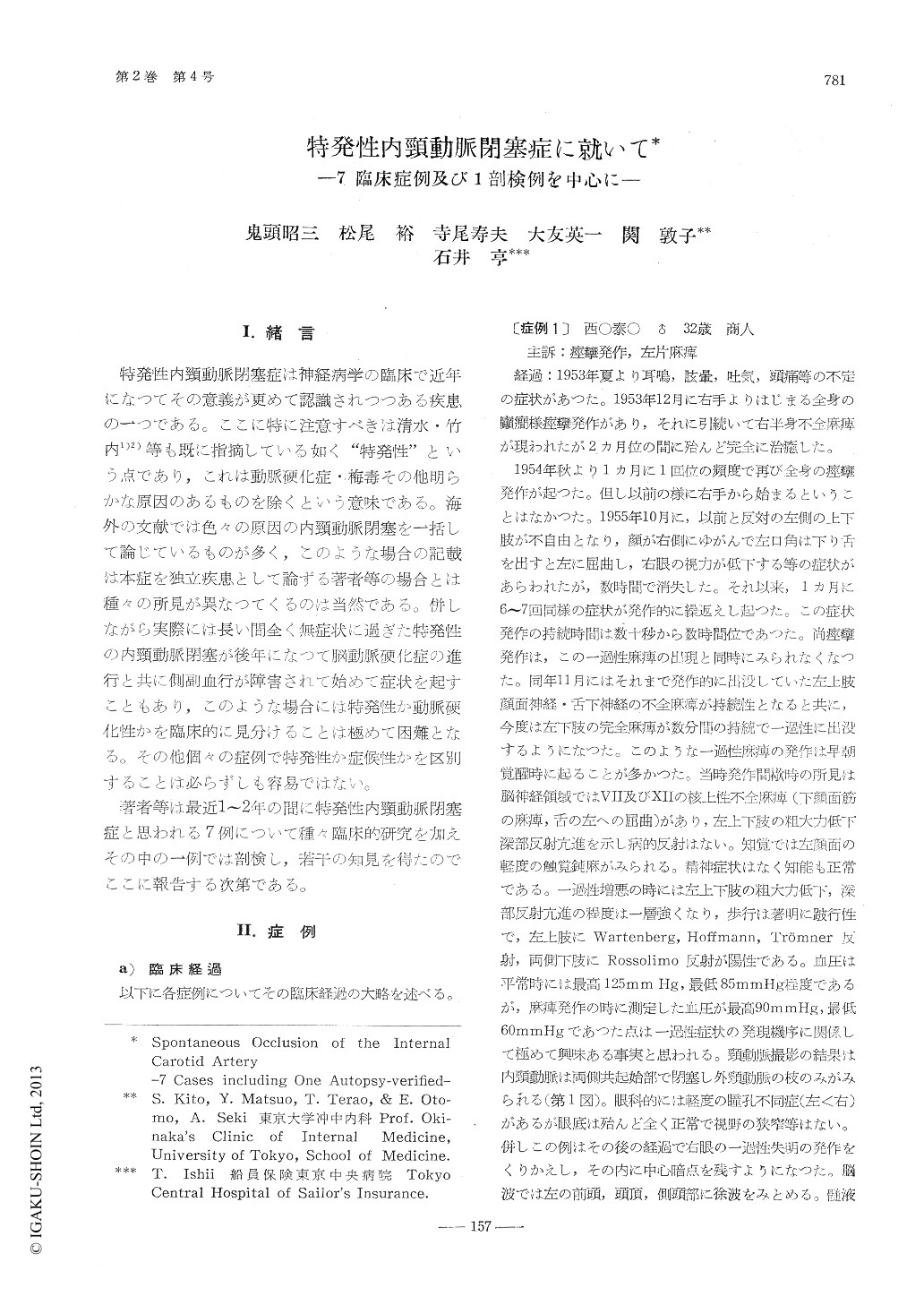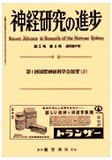Japanese
English
- 有料閲覧
- Abstract 文献概要
- 1ページ目 Look Inside
I.緒言
特発性内頸動脈閉塞症は神経病学の臨床で近年になつてその意義が更めて認識されつつある疾患の一つである。ここに特に注意すべきは清水・竹内1)2)等も既に指摘している如く"特発性"という点であり,これは動脈硬化症・梅毒その他明らかな原因のあるものを除くという意味である。海外の文献では色々の原因の内頸動脈閉塞を一括して論じているものが多く,このような場合の記載は本症を独立疾患として論ずる著者等の場合とは種々の所見が異なつてくるのは当然である。併しながら実際には長い間全く無症状に過ぎた特発性の内頸動脈閉塞が後年になつて脳動脈硬化症の進行と共に側副血行が障害されて始めて症状を起すこともあり,このような場合には特発性か動脈硬化性かを臨床的に見分けることは極めて困難となる。その他個々の症例で特発性か症候性かを区別することは必らずしも容易ではない。
著者等は最近1〜2年の間に特発性内頸動脈閉塞症と思われる7例について種々臨床的研究を加えその中の一例では剖検し,若干の知見を得たのでここに報告する次第である。
Less than 20 cases of spontaneous occlusionof the internal carotid artery without verifia-ble causes like arteriosclerosis, syphilis, etc.have been reported in Japan. There is, how-ever, a high possibility that this disease hasbeen wrongly diagnosed as intracranial tumor,epilepsy or apoplexy. Therefore, its cases mayincrease more and more as cerebral angiogra-phy which is essential for the final diagnosisof this disease is widely performed.
Here we present seven cases of spontaneousocclusion of the internal carotid artery includ-ing one with pathologic findings. Of these,six patients were males, The ages at theonset of the symptoms were ranged from 22years to 42 years, the mean age was 31. Bothsides were affected in three patients, left sidein three, right side in one, suggesting thetendency that the left side is more frequentlyinvolved. The sites of obstruction in four caseswere the first portion of the internal carotidartery, in three the carotid siphons.
The first impressions of these cases were.intracranial tumor in three, epilepsy in one,head trauma In one, apoplexy in one, and neu-roptic myelitis in one. The clinical course ofthis disease can be devided into the followingthree types. 1) Transient and recurrent type(one of our cases). 2) Slowly progressing type(three cases). 3) Apoplectic type (three cases).Special attention should be given to the factthat blood pressure was lowered during thetransient paralysis in our first case. Denney-Brown has insisted that recurrent paralysisin occlusion of the carotid or basilar arteryshould not be attributed to vasospasm, but tothe insufficiency of collateral circulation in-duced by lowered blood pressure (Denny-Brown'ssyndrome).
Hemiparesis seemed to be the most con-stant sign of this disease. As for the cranialnerves, seventh and twelfth nerves were com-monly affected. Ophthalmoscopic examina-tions in all the patients have revealed no ab-normalities including angiosclerosis and vas-cular anastomosis, although four patients show-ed some ophthalmologic symptoms like im-paired vision, narrowing of the visual field,and aniscoria.
It is remarkable that the very strong tubercu-lin reactions were usually seen and one patienthad shown increasing reaction since the start-ing of the disease. In pharmacological exam-inations of the autonomic nerves, reaction toadrenalin seemed to be much stronger in com-parison with ones to pilocarpine and atro-pine. As for blood, coagulation time wasslightly shortened and increassed prothrombinactivity was observed when it was measuredby Links-Shapiro's method. Being differentfrom the cases of arteriosclerosis, plasma fib-rinogen was decreased with resultant normalor lowered blood sedimentation rate. Therewere few abnormalities in plasma 7-globulin,total serum cholesterol, ester-total cholesterolratio, calcium and phosphorus. Slight increasein red cell count was observed.
The histologic examinations of the obstruc-tive artery in one autopsy case revealed sim-ple fibrotic hyperplasia of the intima.
From these clinical and pathological studiesit must be emphasized that the spontaneousocclusion of the internal carotid artery shouldbe regarded as one disease entity of unknownetiology and differentiated from arteriosclero-sis, syphilis, angitis, aneurysm or any othersymptomatic occlusions. Unexplained hemipar-esis in relatively young persons, especially inmales, may well mean carotid occlusion.
A single carotid angiography is not enoughto make diagnosis of organic occlusion of theinternal carotid artery, even if clinical signsare quite suggestive. Angiography should berepeated after intravenous injection of papav-erine hydrochloride to exclude functional vas-ospasm.
Anticoagulants have been used in six caseswith the result of the remarkable improve-ments in one case, some improvements in four,and poor effects in one.
It was concluded in our discussion that spon-taneous occlusion of the internal carotid ar-tery was not a variety of pulseless disease onthe basis of the following points.
1) Females are usually affected in pulselessdisease.
2) Occlusions in pulseless disease are foundin both sides of carotid bifurcations andsubclavian arteries.
3) Impaired vision, peripapillar vascular anas-tomosis in the ocular fundus, and exag-gerated carotid sinus reflex are the mostprincipal symptoms of pulseless disease.
4) Motor weakness is not usually complainedin pulseless disease.
5) Histologically changes in arteries in pulse-less disease usually begin from inflamma-tion of the perivascular portions.

Copyright © 1958, Igaku-Shoin Ltd. All rights reserved.


